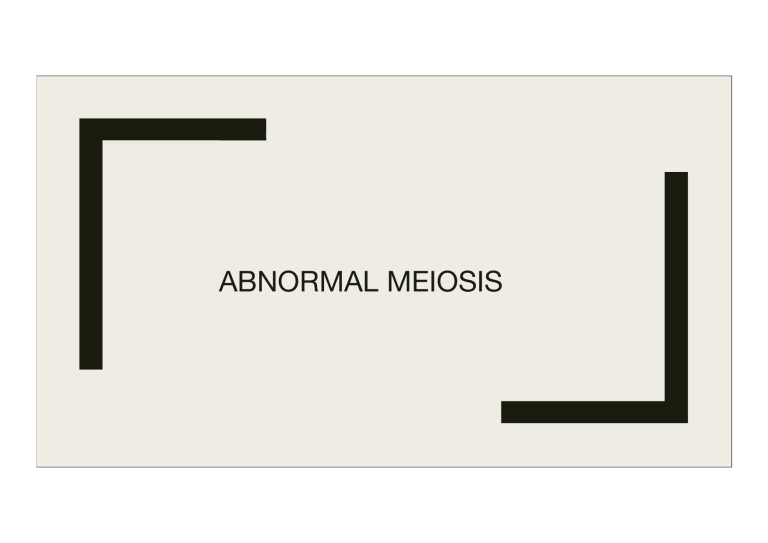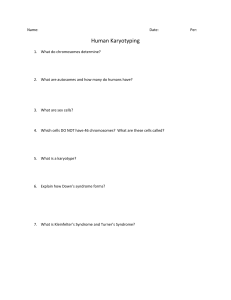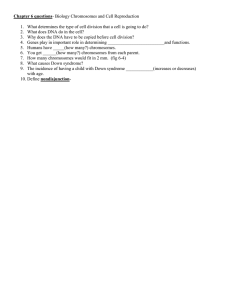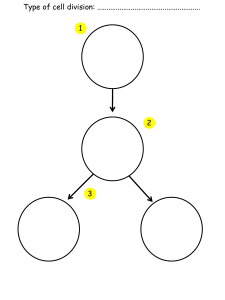
ABNORMAL MEIOSIS Global competencies: Reflection and communication INTRODUCTION ■ Can lead to extra chromosomes = trisomy ■ Can lead to missing chromosomes = aneuploidy or monosomy ■ Chromosomes failing to separate = chromosome non-disjunction ■ If it occurs in the sex chromosomes (X and Y) ■ Fertilization with one of these abnormal gametes results in zygote with extra or missing chromosome = aneuploidy ■ Diagnosis = identifying the illness ■ Prognosis = how the illness will develop KLINEFELTER’S SYNDROME ■ Boy is born with an extra copy of the X chromosome → XXY ■ Sex chromosome within the egg cell splits unevenly ■ Very rare that this will occur in the sperm cell ■ Symptoms in males with this syndrome are not very obvious ■ Symptoms may include: – Sparse body hair – Enlarged breasts – Small testicles and penis – Not very deep voices – Infertile (cannot father children) TURNER SYNDROME ■ Only affects females ■ One of the X-chromosomes is missing (XO instead of XX) ■ Not hereditary – occurs randomly due to incomplete separation during meiosis ■ Infertile – cannot pass along to next generation/offspring ■ Symptoms: – Webbed neck – No growth spurts – Delayed development – Infertility DOWN SYNDROME ■ Extra copy of chromosome 21 ■ Also called trisomy 21 ■ Rare for males to be the cause of Down’s syndrome ■ Occurs during oogenesis ■ The two number 21 chromosomes don’t separate properly during anaphase – both go into the same daughter cell instead of one into each of the two daughter cells. ■ Egg now has two number 21 chromosomes → fertilized egg has three number 21 chromosomes (2 from mother and one from father) ■ New embryo develops by mitosis – has 47 chromosomes Characteristics of Down syndrome ■ Varying degrees of intellectual and developmental delay ■ Distinctive flattened facial features ■ Slanted eyes (due to folds of skin at corners of eyes) ■ Other physical features – short, stubby fingers – Wide space between big and second toe – Large head with different developing ears ■ Heart defects and other health problems ■ Have a happy, loving nature How common is Down syndrome? ■ 1 in 900 births ■ Chances increase with increasing age of the mother: – At age 35 = 1 in 350 chance – At age 45 = 1 in 30 chance ■ Known as maternal age effect = chromosomes have difficulty in separating with aging Children with genetic defects ■ Grow and develop slower ■ May need special needs classrooms – as still need support ■ Offer encounter patronising attitudes and discrimination Aborting the foetus ■ Combination of blood test and ultrasound examination ■ Able to detect 11 weeks after conception ■ More time to allow for decision ■ May also have amniocentesis – small sample of fluid from amniotic cavity in uterus is removed KARYOTYPE ■ A set of chromosomes in a cell ■ Shows the number, size and shape of chromosomes during metaphase of mitosis ■ Show whether a cell originates from male or female ■ Clearly see chromosomal abnormalities Creating a karyotype ■ Nuclei of cultures white blood cells ■ Stimulated to divide by growing in a culture medium for several days ■ Treated with a drug that arrests mitosis in metaphase (easy to identify chromosomes) ■ Chromosomes are dyed, then photographed ■ Software then arranges them into homologous pairs




